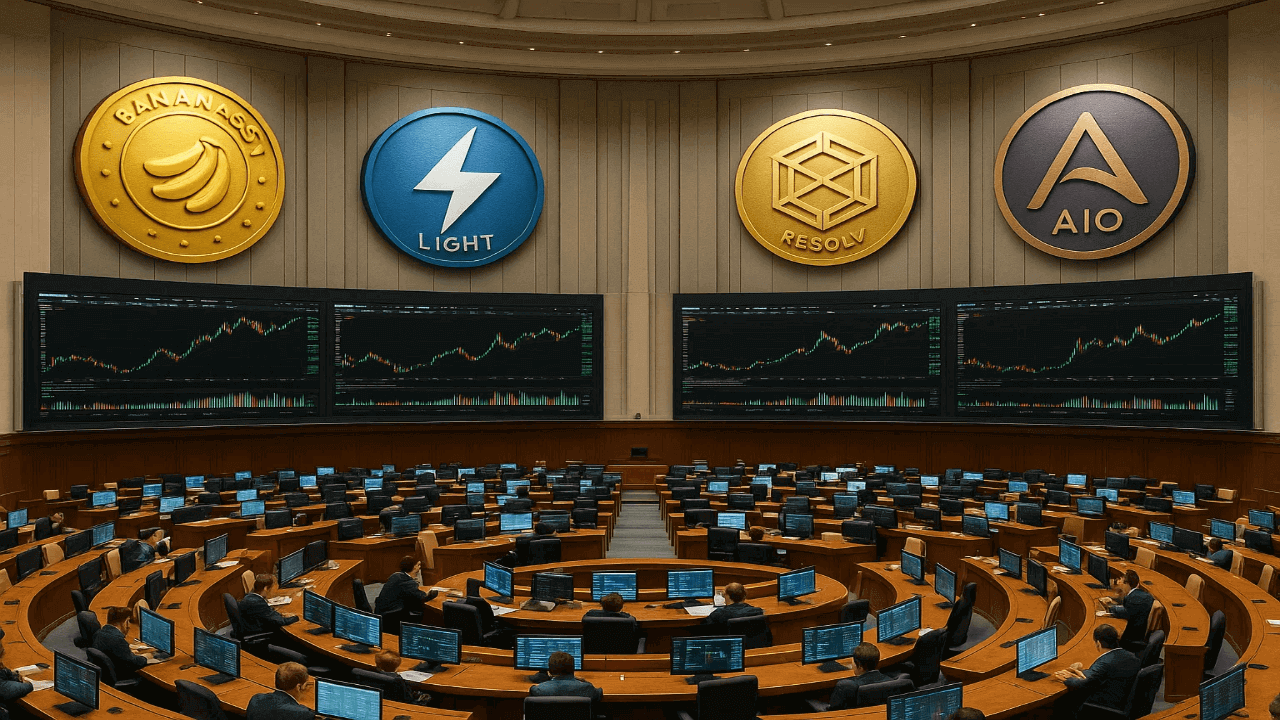Key Takeaways
- AI ETFs spread your money across industries, lowering the risk of loss.
- By investing in AI ETFs, you support new tech companies.
- These ETFs have shown good growth over time with strong results.
- AI ETFs cost less to manage than regular mutual funds.
Artificial Intelligence (AI) is reshaping the global economy, driving innovation and growth across industries. By 2030, AI could add $19.9 trillion to the economy and boost global GDP by 3.5%.
With the AI market projected to grow from $454.12 billion in 2023 to over $2,500 billion by 2032, the demand for AI-driven investments is surging. Among the best AI ETFs available, these funds offer a convenient way to diversify your portfolio while gaining exposure to this transformative technology.
What Are AI ETFs?

AI ETFs, or Artificial Intelligence Exchange-Traded Funds, are investment funds that focus on companies involved in AI technologies and related industries. These ETFs pool resources from multiple investors to create a diversified portfolio of stocks, offering exposure to businesses driving innovation in AI.

Unlike individual stock picking, AI ETFs simplify the investment process by bundling companies across sectors such as robotics, machine learning, big data, and cloud computing.
By investing in AI ETFs, you gain access to a curated selection of companies leading the AI revolution. This approach reduces the complexity of researching individual stocks while providing a cost-effective way to participate in the growth of AI-driven industries.
Why Invest in AI ETFs
Diversification Across AI-Driven Industries
AI ETFs offer a unique advantage by spreading your investment across multiple industries. From healthcare to automotive, AI is transforming sectors globally. Diversification minimizes risk by ensuring your portfolio isn’t overly reliant on the performance of a single company or industry.
For example, the Global X Robotics & AI ETF includes holdings in robotics, automation, and AI software companies, providing exposure to various growth areas.
Exposure to Cutting-Edge Technology
Investing in AI ETFs allows you to stay ahead of technological advancements. Companies within these funds are at the forefront of innovation, developing solutions that shape the future.
For instance, the Roundhill Generative AI ETF focuses on firms pioneering generative AI technologies, which are revolutionizing content creation, customer service, and more.
Potential for Long-Term Growth
The AI sector is experiencing rapid expansion, with applications reshaping industries and driving economic growth. According to industry reports, AI ETFs have shown impressive year-to-date (YTD) performance. The table below highlights the performance and expense ratios of some of the best AI ETFs:
Fund | Performance YTD (%) | Expense Ratio (%) |
|---|---|---|
Global X AI & Tech ETF | 29.1 | 0.68 |
Global X Robotics & AI ETF | 19.9 | 0.68 |
Roundhill Generative AI ETF | 36.2 | 0.75 |
iShares Semiconductor ETF | 14.5 | 0.35 |
VanEck Semiconductor ETF | 42.2 | 0.35 |
Vanguard Information Technology ETF | 33.2 | 0.1 |
WisdomTree AI Fund | 10.9 | 0.45 |
These statistics demonstrate the growth potential of AI ETFs, making them a compelling choice for long-term investors.

Accessibility and Cost-Effectiveness Compared to Individual Stock Picking
AI ETFs simplify investing by bundling multiple stocks into a single fund. This approach reduces the time and effort required to research individual companies. Additionally, ETFs often have lower expense ratios compared to mutual funds, making them a cost-effective option.
For example, the Vanguard Information Technology ETF boasts an expense ratio of just 0.10%, providing affordable access to high-performing tech stocks.
As the ETF market grows, investor confidence in this structure continues to rise. This trend benefits AI ETFs, offering you a reliable and accessible way to invest in the future of technology.

Best AI ETFs 1: Xtrackers Artificial Intelligence and Big Data ETF (XAIX)
Expense Ratio
XAIX boasts one of the lowest expense ratios among AI ETFs at just 0.35%. This makes it an attractive option for cost-conscious investors seeking exposure to the AI and big data sectors.
Assets Under Management (AUM)
As of 2025, XAIX manages over $1.2 billion in assets. Its growing AUM reflects strong investor confidence in its strategy and performance.
Top Holdings
XAIX focuses on companies leading in AI and big data innovation. Its top holdings include:
- NVIDIA Corporation
- Alphabet Inc.
- Microsoft Corporation (MSFT)
- Amazon Web Services (AMZN)
These companies are at the forefront of AI development, from cloud computing to machine learning applications.
Unique Features
XAIX employs a forward-looking approach by screening for companies with approved patents in AI-related fields. This strategy ensures that the fund remains aligned with cutting-edge advancements. Additionally, its focus on big data complements its AI theme, providing diversified exposure to two interconnected growth areas.
Best AI ETFs 2: Global X Artificial Intelligence & Technology ETF (AIQ)
Expense Ratio
AIQ has a competitive expense ratio of 0.68%, aligning with the industry average for AI-focused ETFs.
Assets Under Management (AUM)
With an AUM of approximately $1.8 billion, AIQ is one of the most popular AI ETFs. Its robust AUM highlights its appeal to both retail and institutional investors.
Top Holdings
AIQ includes a mix of established tech giants and emerging innovators. Its top holdings feature:
- Meta Platforms (META)
- Tesla Inc. (TSLA)
- Advanced Micro Devices (AMD)
- Salesforce (CRM)
This diverse portfolio provides exposure to companies driving AI adoption across industries like social media, automotive, and enterprise software.
Unique Features
AIQ stands out for its thematic focus on AI and technology. It tracks the Indxx Artificial Intelligence & Big Data Index, ensuring that its holdings align with the latest trends in AI development. Its inclusion of both hardware and software companies offers balanced exposure to the AI ecosystem.
Top AI ETFs 3: Global X Robotics & Artificial Intelligence Thematic ETF (BOTZ)
Expense Ratio
BOTZ shares the same expense ratio as AIQ, at 0.68%. This makes it a cost-effective choice for investors interested in robotics and AI.
Assets Under Management (AUM)
BOTZ manages over $2 billion in assets, making it one of the largest thematic ETFs in the AI and robotics space.
Top Holdings
BOTZ focuses on companies specializing in robotics, automation, and AI. Its top holdings include:
- Intuitive Surgical (ISRG)
- ABB Ltd.
- Keyence Corporation
- Fanuc Corporation
These companies are leaders in industrial automation, surgical robotics, and AI-driven manufacturing solutions.
Unique Features
BOTZ emphasizes the intersection of robotics and AI, targeting industries like healthcare, manufacturing, and logistics. Its global approach includes companies from the US, Japan, and Europe, providing geographic diversification.
This ETF is ideal for investors seeking exposure to the transformative potential of robotics and AI across multiple sectors.
Best AI ETFs 4: iShares Future AI and Tech ETF (ARTY)
Expense Ratio
ARTY offers a competitive expense ratio of 0.40%. This makes it an affordable choice for investors looking to gain exposure to AI and technology sectors without incurring high costs.
Assets Under Management (AUM)
As of 2025, ARTY manages approximately $1.5 billion in assets. This reflects strong investor interest and confidence in its ability to deliver returns in the rapidly growing AI market.
Top Holdings
ARTY’s portfolio includes a mix of established tech leaders and innovative startups. Its top holdings feature:
- NVIDIA Corporation
- Alphabet Inc.
- ASML Holding (ASML)
- Palantir Technologies (PLTR)
These companies are at the forefront of AI advancements, from semiconductor manufacturing to data analytics and cloud computing.
Unique Features
ARTY stands out for its focus on future-oriented AI technologies. It prioritizes companies investing heavily in research and development to drive innovation.
The fund also includes exposure to emerging markets, offering a global perspective on AI growth. If you’re looking for a fund that balances established players with high-growth potential, ARTY could be a great fit.
Best AI ETFs 5: Roundhill Generative AI & Technology ETF
Expense Ratio
This ETF has an expense ratio of 0.75%, slightly higher than some competitors. However, its specialized focus on generative AI justifies the premium for many investors.
Assets Under Management (AUM)
Roundhill Generative AI & Technology ETF manages $800 million in assets. While smaller than some other funds, its niche focus attracts investors seeking targeted exposure to generative AI.
Top Holdings
The fund’s top holdings include companies leading in generative AI and related technologies:
- OpenAI (via Microsoft)
- Adobe Inc. (ADBE)
- Unity Software (U)
- Snowflake Inc. (SNOW)
These firms are revolutionizing industries like content creation, gaming, and data management through generative AI.
Unique Features
This ETF is one of the few that specifically targets generative AI, a rapidly growing subset of artificial intelligence. It includes companies developing AI models for applications like text generation, image creation, and predictive analytics. If you want to invest in cutting-edge AI technologies, this fund offers a unique opportunity.
Top AI ETFs 6: ROBO Global Robotics and Automation Index ETF
Expense Ratio
ROBO has an expense ratio of 0.95%, which is higher than average. However, its focus on robotics and automation justifies the cost for investors seeking exposure to these transformative industries.
Assets Under Management (AUM)
With over $2.5 billion in assets under management, ROBO is one of the largest ETFs in the robotics and AI space. Its size reflects its popularity among investors.
Top Holdings
ROBO’s portfolio includes a diverse range of companies specializing in robotics and automation:
- iRobot Corporation (IRBT)
- Zebra Technologies (ZBRA)
- Rockwell Automation (ROK)
- Yaskawa Electric
These companies lead in areas like industrial automation, consumer robotics, and AI-driven manufacturing.
Unique Features
ROBO offers global diversification, including companies from North America, Europe, and Asia. Its focus on both hardware and software solutions in robotics and automation provides a well-rounded investment option. If you’re interested in the intersection of robotics and AI, this ETF delivers comprehensive exposure.
Best AI ETFs 7: WisdomTree Artificial Intelligence UCITS ETF (WTAI)
Expense Ratio
WTAI offers an expense ratio of 0.40%, which is competitive within the AI ETF market. This low cost makes it an appealing choice for investors who want to minimize fees while gaining exposure to artificial intelligence. By keeping expenses low, WTAI allows you to retain more of your investment returns over time.
Assets Under Management (AUM)
As of 2025, WTAI manages approximately $1.1 billion in assets. This figure reflects strong investor confidence in the fund’s strategy and performance. The growing AUM also indicates that more investors are recognizing the potential of AI-focused investments.
Top Holdings
WTAI’s portfolio includes a diverse range of companies leading in AI innovation. Some of its top holdings are:
- NVIDIA Corporation (NVDA): A global leader in AI hardware and software solutions.
- Alphabet Inc. (GOOG) (GOOGL): The parent company of Google, driving advancements in AI research and applications.
- Taiwan Semiconductor Manufacturing Company (TSMC): A key player in semiconductor production, essential for AI technologies.
- SAP SE (SAP): A major provider of enterprise software solutions powered by AI.
These companies represent a mix of hardware, software, and services, offering you broad exposure to the AI ecosystem.
Unique Features
WTAI stands out for its focus on European and global companies. While many AI ETFs concentrate on U.S.-based firms, WTAI provides a more geographically diverse portfolio. This approach helps you tap into AI innovation happening outside the United States.
Additionally, WTAI tracks the WisdomTree Artificial Intelligence Index, which uses a rules-based methodology to select companies with significant AI exposure. This ensures that the fund remains aligned with the latest trends in AI development.
How to Choose the Right AI ETF
Evaluate the ETF’s Holdings
When selecting an AI ETF, you should start by analyzing its holdings. The companies included in an ETF determine its exposure to various industries and technologies.
For example, a well-diversified AI ETF might allocate its assets across sectors like information technology, consumer discretionary, and communication services. The table below illustrates a typical sector breakdown for AI ETFs:
Sector | Weight (%) |
|---|---|
Information Technology | 70.6 |
Consumer Discretionary | 11 |
Communication Services | 9.5 |
Industrials | 7.6 |
Health Care | 0.7 |
Materials | 0.3 |
Financials | 0.2 |
Other | 0.1 |
You should also consider the industries represented within the ETF. A strong focus on software, semiconductors, and hardware often indicates alignment with cutting-edge AI technologies. Here's an example of an industry breakdown:
Industry | Weight (%) |
|---|---|
Software & Services | 39.2 |
Semiconductors & Semiconductor Equipment | 18.2 |
Technology Hardware & Equipment | 13.3 |
Media & Entertainment | 9.5 |
Consumer Discretionary Distribution & Retail | 8.8 |
Capital Goods | 3.4 |
Automobiles & Components | 2.2 |
Other | 5.6 |
Geographic diversification is another critical factor. Many AI ETFs focus heavily on U.S.-based companies, but some also include firms from China, South Korea, and Europe. This global approach can help you tap into AI innovation worldwide.
Check the Expense Ratio
Expense ratios play a significant role in determining the cost-effectiveness of an ETF. These fees, expressed as a percentage, represent the annual cost of managing the fund. Lower expense ratios allow you to retain more of your returns over time.
For AI ETFs, expense ratios typically range from 0.47% to 0.95%.
ETF Name | Expense Ratio |
|---|---|
ETF 1 | 0.95% |
IRBO | 0.47% |
ROBT | 0.65% |
While lower expense ratios are generally better, you should also consider the ETF's focus and performance. Specialized funds, such as those targeting generative AI, may have slightly higher fees due to their niche strategies. Balancing cost with potential returns is key.
Review Past Performance
Examining an ETF's historical performance can provide insights into its potential for future growth. Look at metrics like total return, market price, and benchmark performance over different time frames. The table below highlights an example of long-term performance data:
Time Frame | Total Return (%) | Market Price (%) | Benchmark (%) |
|---|---|---|---|
1 Year | -7.61 | -7.95 | -7.67 |
3 Year | -2.14 | -2.23 | -2.34 |
5 Year | 8.24 | 8.14 | 8.39 |
Inception | 5.18 | 5.15 | 5.36 |
While past performance doesn't guarantee future results, consistent returns over longer periods often indicate a well-managed fund.
Understand the ETF’s Theme and Focus
When choosing an AI ETF, understanding its theme and focus is essential. Each ETF has a unique strategy that determines the industries and technologies it emphasizes.
For example, some funds concentrate on robotics and automation, while others target generative AI or big data. This thematic focus shapes the ETF’s holdings and aligns it with specific innovation trends.
A thematic analysis of popular AI ETFs reveals their diverse approaches. The table below highlights the underlying index, description, and fees for four well-known funds:
ETF Name | Underlying Index | Description | Fees |
|---|---|---|---|
ROBO Global Robotics and Automation Index ETF | ROBO Global Robotics and Automation Index | Measures performance of companies in robotics/automation | 95 bps |
Global X Robotics & Artificial Intelligence ETF | Indxx Global Robotics & AI Thematic Index | Invests in companies benefiting from robotics and AI | 69 bps |
iShares Robotics And Artificial Intelligence Multisector ETF | NYSE FactSet Global Robotics and AI Index | Includes companies across developed/emerging markets | 47 bps |
First Trust Nasdaq Artificial Intelligence and Robotics ETF | Nasdaq CTA AI and Robotics Index | Tracks companies engaged in AI, robotics, and automation | 65 bps |
By analyzing an ETF’s theme, you can ensure it aligns with your interests. For instance, if you want exposure to robotics, ROBO or BOTZ might be ideal. On the other hand, if you prefer a broader focus, IRBO offers diversification across multiple markets.
Consider Your Investment Goals and Risk Tolerance
Your financial goals and risk tolerance play a critical role in selecting the right AI ETF. AI ETFs vary in their risk profiles, depending on factors like geographic exposure, industry focus, and market capitalization of their holdings.
For example, funds with a heavy emphasis on emerging technologies may offer higher growth potential but also carry greater volatility.
AI-powered portfolio builders can help align your investments with your goals. These systems analyze data to predict market trends and recommend asset allocations tailored to your risk tolerance. For instance, if you prefer a conservative approach, you might choose an ETF with a diversified portfolio and lower volatility.
Conversely, if you seek high growth, a fund like the Roundhill Generative AI ETF, which focuses on cutting-edge technologies, could be a better fit.
However, it’s important to note that AI-driven strategies don’t guarantee superior outcomes. The Amplify AI-Powered Equity ETF (AIEQ), which uses AI for stock selection, has underperformed the S&P 500 ETF through January 2025. This highlights the importance of balancing AI insights with traditional investment principles.
Intellectia.ai’s Role & Features in Selecting Best AI ETFs
Intellectia.ai simplifies the process of selecting the best AI ETFs by offering advanced tools and insights. Their platform combines real-time data analysis with user-friendly features to help you make informed decisions. Here’s a breakdown of their key offerings:
Feature | Description | Performance Metric |
|---|---|---|
Daily Top Stock Picks | Picks five stocks daily based on market events. | 36% return, 258% annualized return |
Technical Analysis | Provides high-quality stock analysis reports quickly. | Covers 10,000+ US stocks and ETFs |
Swing Trading | Extracts insights from historical data for trading signals. | Backtested models for reliability |
Should I Buy | Offers analysis reports based on real-time data and market sentiment. | Concise recommendations for investors |
Stock Monitor | Tracks market trends and individual stock performance in real time. | N/A |
These features empower you to evaluate ETFs based on their holdings, expense ratios, and performance. For example, the "Should I Buy" tool provides concise recommendations, while the "Technical Analysis" feature delivers in-depth reports on over 10,000 stocks and ETFs.
Conclusion
AI ETFs offer a smart way to diversify your portfolio while gaining exposure to transformative industries. They provide access to cutting-edge technologies and long-term growth opportunities.
Diversification reduces risk, as shown by time-series momentum strategies, which have delivered consistent returns even during market downturns. By exploring the best ai etfs listed here, you can align your investments with future-focused trends.
For personalized advice, consider consulting a financial advisor to ensure your choices match your financial goals.










